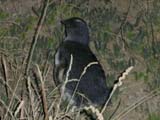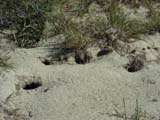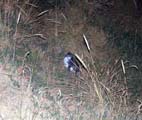The little penguin, also caked the fairy penguin, is the smallest
of all the world's penguins and is found only in southern Australia
and New Zealand.
Indigenous people in these areas would have known
the little penguin well.
The first written description was made in 1781 by J.R. Forster
from a specimen previously collected on one of Captain Cook's voyages.
Forster's scientific name for the birds was Eudyptula minor, which
means "good little diver" in Greek.
Although some little penguins return to their burrows
throughout the year, most remain at sea for long periods during
autumn and winter.
When they come ashore penguins are extremely
vulnerable to predators.
Foxes are a major threat to penguins.
Most return to their burrows in small groups within the first
two hours of darkness.
Often penguins group beyond the surf, seeking the safety of numbers before coming
ashore.
In some cases hundreds of birds may arrive within quite a brief space of time.

|
They are superbly adapted for life in the water.
With a streamlined body, short wings modified as paddles, and by using their
feet and tails for manoeuvring, little penguins literally fly underwater.
At sea the short stiff feathers compress forming a thin watertight
barrier, below which downy filaments trap air close to the
body, insulating the birds when diving.
Oil spills spell disaster for penguins and other sea birds.
Not only is oil toxic when ingested, but it also removes the buoyancy and insulation
of the specialised penguin feathers.
Adult birds weigh about one kilogram and grow to a height
of 40 cm.
On average birds live for seven years, taking two to three years to reach maturity.
They feed mainly on small fish, squid, and krill (shrimp-like crustaceans), which
they obtain during shallow short dives, usually to depths of 5 to 20 metres. |

|
Between June and August male penguins return to the land
to renovate old burrows or dig new ones.
Their noisy courting displays greet arriving female penguins.
Only one mate is chosen; mates stay together for years.
Little penguins commonly breed in loose colonies.
Birds raise one or two clutches
each year depending on food availability.
A clutch of two large
eggs is typically laid during spring or summer.
Both parent birds alternate between incubation and feeding at sea.
About 36 days later the young hatch. |

|
When five weeks old, downy juveniles may be seen outside
burrows at night waiting to be fed.
After 8 weeks the chicks are ready to move to their new life at sea.
After breeding adult penguins return to their burrows to moult.
Over the two to three weeks of moulting, all feathers are shed
and replaced.
During this time penguins are unable to feed at sea and they
can lose up to half of their body weight. |
Bits and pieces ....
Do you know why penguins are coloured the way they are?
The dark colouring of the back and the silvery underside of the
penguins helps camouflage the birds from predators.
When seen from above the dark upper surface blends in with the
sea, while the white belly is similar to the surface reflections
when seen from beneath. This also helps the penguins avoid being
detected by the fish or squid they are hunting.
Penguins are able to see equally well on land and under water.
The unique structure of the penguin's eye alters the focus according
to the environment in which it is trying to see.
A 'third eyelid' protects the eye underwater and is used as a 'windscreen
wiper' to clear sand from the eye when on land.
Penguins only sleep for about four minutes at a time.
Their deepest sleep stage lasts only 10 seconds compared to an
average of 20 minutes for humans.
|


